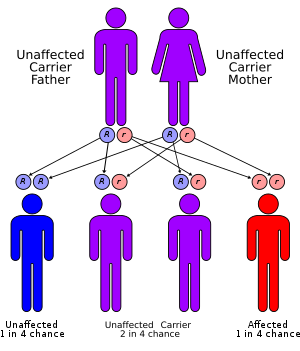Impossible syndrome
Impossible Syndrome, is a complex combination of human congenital malformations (birth defects).[1]
| Impossible syndrome | |
|---|---|
| Other names | Chondrodysplasia situs inversus imperforate anus polydactyly |
 | |
| Impossible syndrome has an autosomal recessive pattern of inheritance. | |
The malformations include chondrodysplasia (improper growth of bone and cartilage), situs inversus totalis (chest and abdominal organs all a mirror image of normal), cleft larynx and epiglottis, hexadactyly (six digits) on hands and feet, diaphragmatic hernia, pancreatic abnormalities, kidney abnormal on one side and absent on the other side, micropenis and ambiguous genitalia, and imperforate anus.
Only one case of Impossible Syndrome has been reported; the infant was premature and stillborn.
Genetics
The inheritance of Impossible syndrome is suspected to be autosomal recessive, which means the affected gene is located on an autosome, and two copies of the gene - one from each parent - are required to have an infant with the disorder.
Diagnosis
References
- Fraser FC, Jequier S, Chen MF (1989). "Chondrodysplasia, situs inversus totalis, cleft epiglottis and larynx, hexadactyly of hands and feet, pancreatic cystic dysplasia, renal dysplasia/absence, micropenis and ambiguous genitalia, imperforate anus". Am J Med Genet. 34 (3): 401–405. doi:10.1002/ajmg.1320340316. PMID 2596528.